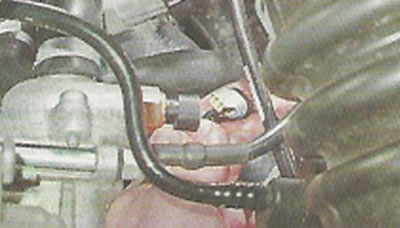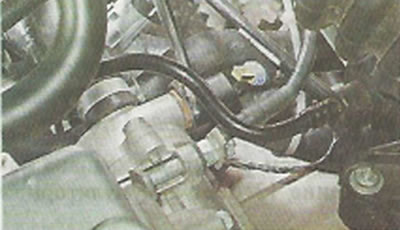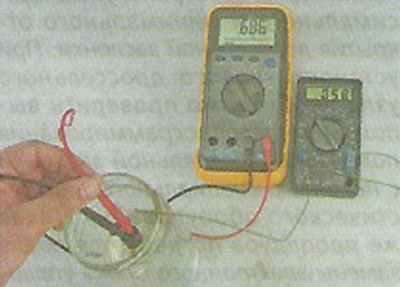To complete the work you will need:
- multimeter (in the voltmeter mode, an ohmmeter with a measurement limit from 100 Ohm to 10 kOhm):
- thermometer (with a change limit of at least 100°С);
- a small heat-resistant container with a volume of about 0.5 liters for water;
- about 0.3 liters of water, heated to boiling point.
Advice. The thermometer can be replaced with a digital multimeter with thermometer mode.
Removal and inspection
1. Drain the coolant («Coolant - replacement»).
2. We release the clamp of the wiring harness block, disconnect the block from the sensor.

3. Connect «negative» voltmeter probe to «mass» engine.
4. Turning on the ignition, use a voltmeter to measure the voltage at terminal 1 of the wiring harness block (the designation of the conclusions is applied on the block of the wiring harness).
Comment. The voltage at the output must be at least 12 V. If the voltage is not supplied to the block or it is less than 12 V, then the battery is discharged, the power circuit is faulty or the computer is faulty.
Warning! Turn off the ignition after the voltage measurement is completed.
5. Using a 19 mm spanner wrench, unscrew the temperature sensor and remove it from the thermostat housing. The connection between the sensor and the thermostat is sealed with a copper washer.

6. Connect an ohmmeter to the sensor terminals.
Comment. To connect a multimeter, pieces of PVC tubing can be put on the sensor leads. Insert the probes of the device into them. This must be done carefully, since the sensor leads are very thin.
7. We fill the container with boiling water, immerse the working part of the sensor in water and record the readings of the device at a temperature of about 100°C. As the water cools, we measure the resistance of the sensor at a temperature of 90. 80, 70, 60, 50, 45, 40, 35, 30, 25 and 20°C.

If conditions permit, readings can be taken at a lower temperature. The resistance of a good sensor should be close to the data given in the table:
| Coolant temperature,°С | Sensor resistance, Ohm |
| 100 | 177 |
| 90 | 241 |
| 80 | 332 |
| 70 | 467 |
| 60 | 667 |
| 50 | 973 |
| 45 | 1188 |
| 40 | 1459 |
| 35 | 1802 |
| 30 | 2238 |
| 25 | 2796 |
| 20 | 3520 |
| 15 | 4450 |
| 10 | 5670 |
| 5 | 7280 |
| 0 | 9420 |
Replace the defective sensor.
Installation
1. Install the sensor in the reverse order of removal.
2. Fill the engine cooling system with liquid.
3. We start the engine and make sure there are no coolant leaks from under the sensor. If necessary, we wrap the sensor more strongly in the thermostat housing.
Recommendation. If it was not possible to eliminate the leak in this way, the sensor should be reinstalled by applying a heat-resistant sealant to its threaded part or replacing the copper washer.
